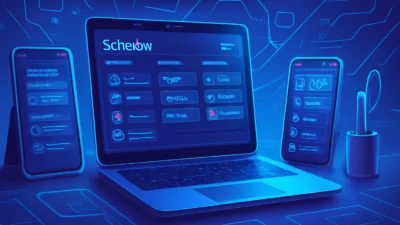Think of a school in which there are no students who fall through the cracks, in which the teachers and counselors can identify issues before they turn into crises. Educational Early Warning System Software is making this vision a reality very fast.
These mighty digital tools assist schools in making sure that the students can be supported before they are overpowered by academic problems.
However, what is an Educational Early Warning System Software, and how does it operate? So, here we go, and how this technology is changing the world in terms of classrooms.
What Is an Educational Early Warning System Software?
A Modern Solution for Student Success
Educational Early Warning System Software is a kind of digital tool that is used to detect students who might face the danger of academic failure, dropping out, or any other school-related problems. It provides timely notification to the schools and teachers, based on a broad scope of data (attendance, grades, behavior, and participation), which enables quick and efficient response.
Why Schools Need Early Warning Systems
Teachers are used to using intuition or random data to identify struggling students in the past. Nevertheless, as the numbers of classes increase, and there are various learning requirements, the initial signs of trouble can be overlooked.
The early warning system software is a technology that is used to identify these signs early enough to ensure all the students receive the support they require to be successful.
How Does Educational Early Warning System Software Work?
1. Data Collection
The initial one is the gathering of information. The software collects data on various sources, including:
- Attendance records
- Grades, test scores Academic performance.
- Behavior reports
- Community involvement in schools.
- The social and emotional indicators.
This information is typically automatically drawn out of a school already existing management systems, thereby cutting down on the manual labor of employees.
2. Data Analysis and Pattern Recognition
After data collection, it is then analyzed using the software through sophisticated algorithms. It searches for patterns or changes, which may indicate that a student is on a downward path. As an illustration, an unexplained decline in grades, regular absences or disciplinary activities could raise a red flag.
3. Real-Time Alerts and Notifications
In the event of a risk being detected, the software notifies the teachers or counselors or administrators in real time. Such alerts point to the issue and give an understanding of the students who require immediate attention.
4. Customized Interventions
Using this information, teachers can create unique support plans, such as additional tutoring, counseling, or visiting with the parents. The software is also useful in monitoring the success of interventions and making necessary amendments.
Key Features of Educational Early Warning System Software
| Feature | Benefit |
| Automated Data Sync | Keeps information up to date with minimal effort |
| Customizable Alerts | Focus on what matters most for each school |
| Visual Dashboards | Make data easy to understand briefly |
| Intervention Tracking | Monitors which strategies are working |
| Secure Access | Protects student privacy and sensitive information |
| Communication Tools | Connect teachers, parents, and counselors |
Why Early Warning Systems Matter
Keeping Students on Track
Schools can avoid small problems before they develop into a big hindrance to learning. This proactive measure implies that a larger number of students remain on track to complete their studies and attain their objectives.
Reducing Dropout Rates
Research indicates that the dropout rates can be greatly minimized with the help of early warning software. Students can receive assistance when they need it early; this way, they are more likely to remain engaged and complete their learning process.
Supporting Teachers and Counselors
Teachers are already overstretched. These systems remove the element of guessing on the students in distress and putting the received time towards teaching and assistance.
List: How Schools Benefit from Educational Early Warning System Software
- Earlier detection of students at-risk.
- Individual intervention strategies.
- Better coordination between employees and students and parents.
- More effective use of data to make decisions.
- Better interaction with students and higher results.
- Less dropout and failure rates.
- Effective monitoring of intervention results.
Who Uses Educational Early Warning System Software?
Technology does not apply to a specific type of school. This is where it leaves its mark:
- It is used in public and non-public K-12 schools to serve students of all ages.
- It is the key to being used in colleges and universities to enhance retention and graduation rates.
- District administrators use the data at the district level to achieve improved resource allocation.
- It is employed by special education coordinators to differentiate instruction for students with special needs.
Common Early Warning Indicators
Academic Performance
A gradual decline in grades or constant failure in major subjects may be a sign that a student is in distress.
Attendance
More absences or lateness are usually an indication of disinterest or external pressures.
Behavior
Red flags include disciplinary measures, classroom behavioral change or more referrals.
Social and emotional Factors.
The software is also likely to pick up bullying, family issues or emotional distress when coupled with other data.
Two Key Benefits
1. Proactive and Personalized Support
Educational Early Warning System Software enables the teacher to intervene at the appropriate level at an early stage. Schools can solve problems before they become complicated and establish a better and beneficial learning atmosphere for all students instead of waiting for a crisis.
2. Data-Driven Decisions
School leaders can make more intelligent decisions regarding resource allocation with properly understood reports and easily readable ones. This is to make sure that the interventions are effective and that no student is left behind.
How to Choose the Right Early Warning System Software
These are the factors to be considered when choosing which software to implement:
- Convenience: The system must be user-friendly to the teachers and administrators.
- Integration: It must be able to integrate well with your existing student information systems.
- Customization: Find software that lets you establish your risk indicators and thresholds.
- Security: Privacy of student data is essential- ensure that it has solid security measures.
- Support and Training: Good providers provide staff with continuous support and training
Challenges and Considerations
These systems are not magical solutions, as they are powerful. Judgment by human beings remains crucial. Risks can be identified by software; however, teachers and counselors are important in interpreting data and dealing with students. In addition, the schools should make sure that the interventions are balanced and are aware of individual student backgrounds.
Conclusion
The world of classrooms is evolving, as well as the tools that help students to succeed. The Early Warning System Aerial Software Educational is not merely a fad; it is an essential tool for present-day learning.
Using the power of data and technology, schools can detect trouble at an early stage, deal with it swiftly, and present each child with the best opportunity to achieve success.
As an educator, parent, or policymaker, it is the right moment to better understand such systems and the ways they can assist your school community. The future of education is better, secure and conducive than ever with the Educational Early Warning System Software.





